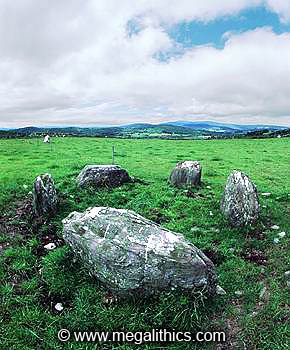
 |
|
Photo Gallery |
|
|
VR Panoramas |
|
| W 303 800 (Pub.) | Diameter 4.1 x 3.6m (Pub.) |
| Visited July 1998 |
Also known as Lackaduv, Knockraheen is a
complex site comprising a stone circle, radial cairn and at least one stone row. The circle itself is a small five stone Irish recumbent, the
stones are low, their heights in the range 0.6 - 0.9m dropping down towards the
axial stone. The circle has a NE-SW alignment with an internal axial length of
4m.
Around 23m SW of the circle is a stone row, or strictly speaking, a standing
stone pair. The stones stand just over a metre apart with their flat faces
aligned NE-SW on the stone circle. The stones are of quartzite, the NE stone
1.05m tall, and the SW stone 1.25m tall.
70m SE of the stone circle is a radial-stone cairn, a low circular cairn of
stones with a series of radially aligned stones set within the cairn and
protruding from it. The Knockraheen cairn has a diameter of around 7.5m and is
around 1m high, it has six to seven radial stones which are between 0.2m and
0.7m tall. The cairn is surrounded by a ditch and external bank giving the
entire monument an overall diameter of 18m.
Radial-stone Carins are quite rare monuments, only nine others being known in
Ireland as of 1998 (see also Kealkill and Knocknakilla).
Burl (1), has speculated that these cairns
are Irish versions of the Scottish ring-cairns, in Scotland the cairns are edged
with a continuous kerb of upright slabs or boulders, whereas in the Cork and
Kerry region the cairns have the "kerbs" protruding from their sides "like the
ratchets of a cog-wheel". Radial-stone cairns are currently thought to be burial
monuments of Bronze Age date (2).
1.
Burl A.
From Carnac to Callanish:
the prehistoric stone rows and avenues of Britian, Ireland and Brittany,
p.192, Yale University Press, 1993,
Newhaven & London.
2.
O'Nuallain S, Journal of the Royal Society of Antiquaries of Ireland, 114, p.63-79, 1984.